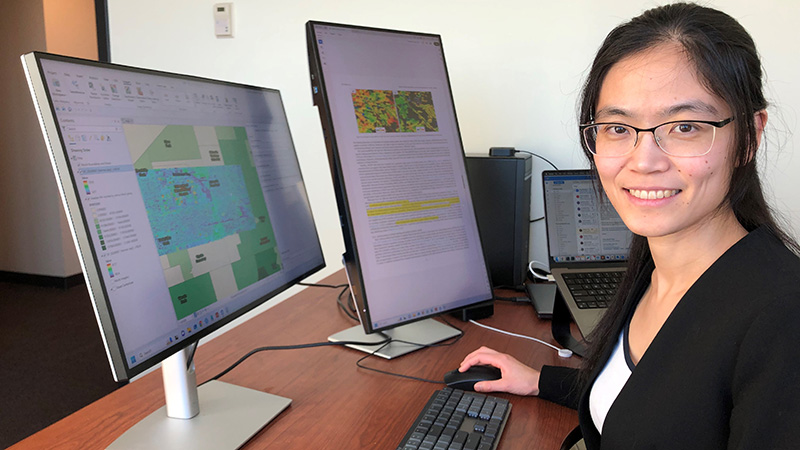
By Ronica Stromberg
Flying into a large city at night, Xiaomeng Li looked down through the plane window and had an epiphany. She saw roads running through the city like veins in a huge organism. The traffic was the organism’s blood, with tiny dot-like vehicles transporting goods to people who supported the entire system.
“It was like this giant, loosely connected network with smaller clusters, and with long lines loosely connected to other networks of towns and villages,” she said. “So, that was beautiful.”
Looking at the patterns, she wanted to describe them not with words but with numbers.
“I wanted to quantitatively study that,” she said.
Li now uses her skills in geospatial technologies to do similar work on two grants at the University of Nebraska–Lincoln. She is a co-principal investigator on a Grand Challenges award, Climate Resilient Heartland: Leveraging AI for Equitable Risk Reduction and Adaptation Across Rural and Urban Systems. She is senior personnel on a USDA grant, Data Solutions for Climate Smart and Resilient Agriculture.
On the Grand Challenges award, she is striving to understand climate change and how cities, towns and rural communities can be built to be more climate resilient. She uses geographic information systems to map out amenities and then analyzes how accessible those amenities are to different areas. She may ask questions of equity such as do people have the same access to health care for heat stroke and are they able to grow trees and a lawn to help cool the air?
On the USDA grant, she is supporting the team by using GIS to analyze and create visualizations of data and then loading that information to an online platform she will create with colleagues. Farmers and other locals will then be able to view the information and play around with the data to decide how they might make their own operations more climate friendly and resilient.
“I'm just trying to jump on board on teams and trying to contribute but also trying to develop my own research and program here because what I want to do is combine my own skills and interests with what is unique in Nebraska,” Li said.
While her expertise has been in studies of built environments, she said she is open to any collaboration, including agriculture, although she is still learning about that. She said she is striving to find ways to reach out to rural communities to understand their needs for research.
“I will start by having some preliminary data and go to stakeholders and see if they find this helpful, or if not, what is something related they want to address,” she said. “And then, hopefully, it will be like a back-and-forth process for me to cocreate knowledge and support decision making.”
Li is relatively new to her current position, originally coming to Nebraska in 2022 as a lecturer hired by the School of Global Integrative Studies and the School of Natural Resources. In May 2024, she became a full-time research assistant professor in the School of Natural Resources.
She said a key term for the kind of research she wants to do is sustainability, achieving good for the environment with efficiency and equity.
“I just want to model these complex systems with numbers and models, and GIS will be a tool,” she said. “Remote sensing will be a very useful tool for me to gather data and to get insights on the ground as well.”
She co-teaches Introduction to Geospatial Technologies, showing students how to gather, analyze and visualize geospatial data using GIS, remote sensing and GPS.
Li learned geospatial techniques while training as a geographer at two Chinese universities and Michigan State University. She then worked as a visiting scholar, studying networks in Detroit and how people accessed amenities. She said she was interested in identifying and remediating injustices in the system, such as people in poorer areas having to drive farther for groceries.
Early in life, she showed a strong aptitude for geography and math. She said she wants to use these skills to make better environments for everybody to live in and she enjoys this line of work.
“I just love numbers and love quantifying the phenomenon we see every day, like when we walk outside, the patterns of where things are located and their relationships,” she said.